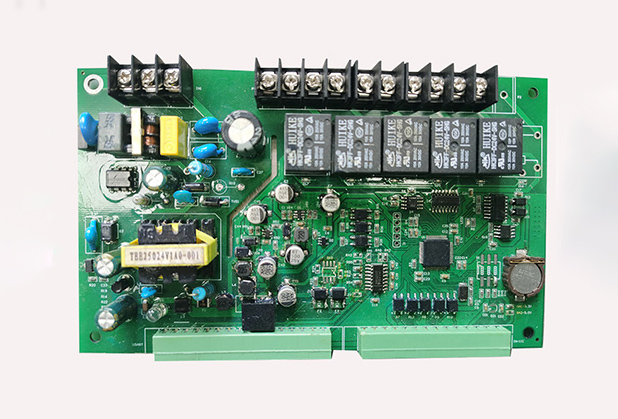[Internal circuit] Cut the copper foil substrate into a size suitable for processing and production. Before pressing the film on the substrate, it is usually necessary to roughen the copper foil on the surface of the substrate by brushing and micro-etching, and then attach a dry film photoresist to it under appropriate temperature and pressure. The substrate with dry film photoresist is sent to an ultraviolet exposure machine for exposure. The photoresist polymerizes after being irradiated by ultraviolet rays in the transparent area of the film, and transfers the line image on the film to the dry film light on the board. On the glue. After tearing off the protective film on the film surface, develop the unexposed areas on the film surface, remove it with a sodium carbonate aqueous solution, and then use a hydrogen peroxide mixed solution to corrode the exposed copper foil to form a circuit. After that, the dry film photoresist that has been retired after work is washed away with a light sodium oxide aqueous solution.

[Pressing] The finished inner circuit board is bonded with glass fiber resin film and outer circuit copper foil. Before pressing, the inner board should be blackened (oxidized) to passivate the copper surface and increase insulation; and make the copper surface of the internal circuit rough, so as to produce good adhesion to the film. When overlapping, use a riveting machine to rivet the inner circuit boards of more than six layers of circuits in pairs. Then, the film is neatly stacked between the mirror steel plates with a tray and sent to a vacuum press to harden and bond the film at an appropriate temperature and pressure. After pressing, the target hole drilled by the X-ray automatic positioning target machine is used as the reference hole for the alignment of the inner and outer circuits. The edge of the board should be finely cut to facilitate subsequent processing.
[Drilling] Use a CNC drilling machine to drill the circuit board, drill the through holes of the circuit between layers and the fixed holes of the welding parts. When drilling, use pins to fix the circuit board on the drilling machine table through the pre-drilled target holes, and add a flat lower substrate (phenolic resin board or wood pulp board) and upper cover board(aluminum board) to reduce drilling The appearance of pore burrs
[Plated through hole] After the formation of the interlayer conductive channel, a metal copper layer needs to be built on it to complete the conduction of the interlayer circuit. First, use heavy brushing and high-pressure washing to clean the hair on the hole and the dust in the hole, and soak and paste tin on the cleaned hole wall
[Native copper] Palladium colloid layer, and then reduce it to metallic palladium. The circuit board is immersed in a chemical copper solution, and the copper ions in the solution are reduced and deposited on the hole wall under the catalysis of palladium metal to form a through-hole circuit. Then, the copper layer in the through hole is thickened by copper sulfate bath electroplating to a thickness sufficient to resist the influence of subsequent processing and use environment.
[Secondary copper for external circuit] The production of circuit image transfer is similar to that of internal circuit, but there are two production methods for circuit etching, positive film and negative film. The production method of the negative film is the same as that of the internal circuit. After development, it is done by directly etching the copper and removing the film. The positive film is produced by secondary copper and tin-lead plating after development (the tin-lead in this area will remain as a resist in the subsequent copper etching step). After the film is removed, the exposed copper foil is washed with alkaline ammonia and chlorine The copper compound solution is etched away to form a circuit. .Later, use tin-lead stripping solution to peel off the tin-lead layer that has been decommissioned after get off work (the tin-lead layer was retained in the early days, and it was used to cover the circuit as a protective layer after remelting, and it is not used now).
[Solder Resistant Ink Character Printing] The early green paint was screen-printed and then directly baked (or irradiated with ultraviolet rays) to harden the paint film. However, during the printing and hardening process, the green paint often penetrates into the copper surface of the circuit terminal contacts, causing troubles to the welding and use of the parts. Now, in addition to using circuit boards with simple and rough lines, photosensitive green paint is also used for production. The text, trademark or part mark required by the customer is printed on the board by screen printing, and then the text is hardened by thermal drying (or ultraviolet irradiation).
[Contact processing] The solder resist green paint covers most of the copper surface of the circuit, and only the terminal contacts are exposed for part welding, electrical testing, and circuit board insertion and removal. An appropriate protective layer should be added to the terminals to avoid oxides on the terminals connected to the anode (+) during long-term use, which will affect the stability of the circuit and cause safety issues.
[Forming and cutting] Use a CNC forming machine (or die punching machine) to cut the circuit board into the external dimensions required by the customer. When cutting, use pins to pass through the pre-drilled positioning holes to fix the circuit board on the base (or mold). After cutting, the golden finger part is processed by grinding the bevel to facilitate the insertion and use of the circuit board. The circuit board composed of multiple connectors needs to add an x-shaped fold line, which is convenient for customers to disassemble and disassemble after plugging in. After that, clean the dust on the circuit board and the ionic contaminants on the surface.
[Inspection board packaging] Commonly used packaging PE film packaging, heat shrinkable film packaging, vacuum packaging, etc.